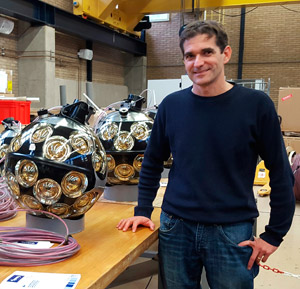KM3NeT
The UPV takes part in the construction of the largest neutrino telescope in the world through the IGIC (Gandia campus)
[ 17/12/2015 ]
The Universitat Politècnica de València (UPV), through the Acoustic Research for Astroparticle Detection Group –which is led by Professor Michael Ardid and is part of the Research Institute for the Integrated Management of Coastal Areas (IGIC), located at the UPV’S Gandia campus–, is taking part in the construction of KM3NeT, the largest neutrino telescope in the world.
Specifically, the UPV, whose doctoral student Maria Saldana Coscollar earlier this month attended the deployment and control of the installation of KM3NeT's first detection line, off the coast of Capo Passero (near Sicily, Italy), developed its acoustic transmitters together with MSM SLL, a Valencian company.
UPV researchers worked on the design of KM3NeT's acoustic positioning system, which is necessary for monitoring the position of the optical modules under the sea in order to reconstruct the trajectories of neutrinos with an angular precision greater than one degree.
Neutrinos, "messengers" with information from the edges of the Universe
As explained by Professor Ardid, neutrinos are the most elusive elementary particles. Coming from the edges of the Universe, they are able to pass through planet Earth unaltered. It is not easy to detect them, and it requires a huge volume of instruments.
As a matter of fact, the KM3NeT telescope will occupy more than one cubic kilometer of sea water, with hundreds of detection lines, such as the one recently installed, in order to capture the weak light signal generated by neutrinos in abyssal darkness.
The detection of neutrinos allows us, in the first place, to complement conventional telescopes and to study the universe’s multiple phenomena through these messengers, and secondly, to study the fundamental properties of these particles, which are crucial for understanding the most recent physics theories.
A decisive step that demonstrates the viability of a technology developed after 10 years of research
"The installation of this first line," said Ardid, "is a decisive step for KM3NeT, not only because this marks the beginning of its construction, but also because it demonstrates the viability of the technology developed after a decade of research. KM3NeT will also be able, due to its peculiar location, to host marine and land science experiments.".
Improved performance and cost-efficiency with respect to ANTARES, a project in which the UPV also took part
KM3NeT is a project that is the result of international cooperation by more than 200 scientists from 40 institutions and 10 countries. Within Spain, in addition to the UPV, the Institute for Corpuscular Physics and the Universitat Politècnica de Catalunya also worked on the project.
The idea of building the optical modules with many small photomultipliers, called multi-PMT, instead of using modules with a single photomultiplier, is one of the new project’s main innovations with respect to previous experiments such as ANTARES (also located in the Mediterranean) and IceCube (at the South Pole). This allows KM3NeT's multi-PMT modules to offer improved performance and cost-efficiency.
Because of the above, KM3NeT will increase the scientific potential of its predecessor, ANTARES, a project which in which the UPV also took part and which produced results such as the development of the map of the southern sky based on neutrinos, the establishment of limits for the detection of dark matter and the study of catastrophic astrophysical events.
Noticias destacadas
 Acabar con la pobreza infantil en España aumentaría el PIB un 5'7%
Acabar con la pobreza infantil en España aumentaría el PIB un 5'7%
La pobreza infantil en España, a debate en unas jornadas organizadas por la Cátedra de Infancia y Adolescencia de la UPV, en Torrevieja
 QS rankings por materias
QS rankings por materias
La UPV, reconocida como mejor universidad de España para estudiar tanto Ingeniería Agroalimentaria y Forestal como Arte y Diseño
 La 'Escuela de Diseño' cambia de nombre
La 'Escuela de Diseño' cambia de nombre
La ETSIADI (Escuela Técnica Superior de Ingeniería Aeroespacial y Diseño Industrial) sustituye la denominación de ETSID
 La UPV, en la semifinal de Solo de Ciencia
La UPV, en la semifinal de Solo de Ciencia
Entre los diez semifinalistas, se encuentran Miguel López, investigador del CVBLab-Human Tech y Carolina Ropero, doctoranda en la UPV
 Primeros pasos del museo Ciència fallera de la UPV
Primeros pasos del museo Ciència fallera de la UPV
La UPV celebra el acto de entrega de premios del I concurso "La Ciència a les Falles". Los ninots ganadores, los primeros de este nuevo museo de la universidad
 UPV-CLÍNIC
UPV-CLÍNIC
La UPV e INCLIVA firman un convenio para impulsar conjuntamente la innovación en el ámbito de la salud







